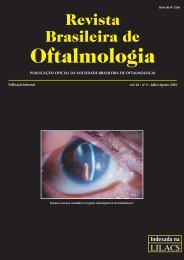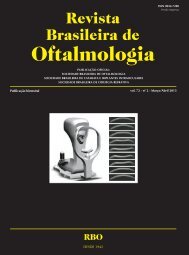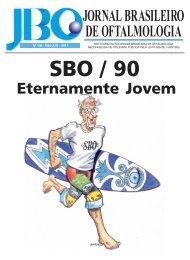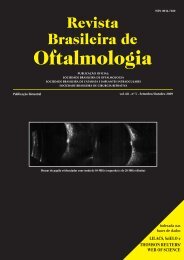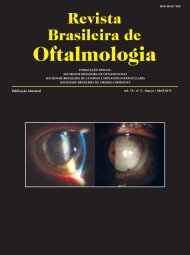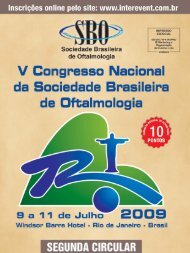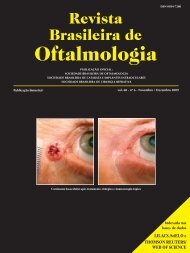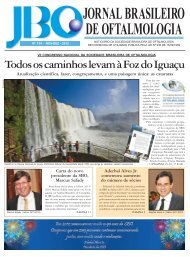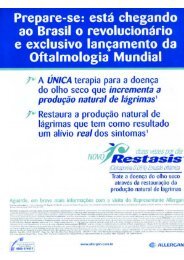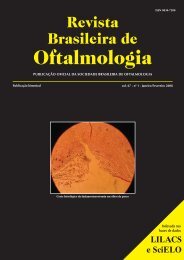nº 4 - Julho / Agosto 2010 - Sociedade Brasileira de Oftalmologia
nº 4 - Julho / Agosto 2010 - Sociedade Brasileira de Oftalmologia
nº 4 - Julho / Agosto 2010 - Sociedade Brasileira de Oftalmologia
You also want an ePaper? Increase the reach of your titles
YUMPU automatically turns print PDFs into web optimized ePapers that Google loves.
262<br />
Cury D, Boa-Sorte N, Lyra IM, Zanette AD, Castro-Lima H, Galvão-Castro B, Gonçalves MS<br />
our results, additional studies are warranted to <strong>de</strong>termine<br />
if these findings are related to an increase of vasoocclusive<br />
crisis among these specific ages or with the<br />
presence of others biomarkers for assessing relative risk<br />
in these group of SCA patients.<br />
This is the first study of ocular lesions among<br />
HBSS and HBSC patients from Bahia. The lower<br />
percentage of severe proliferative retinopathy found<br />
among HBSS patients when compared to HBSC patients<br />
could be attributed to auto infarction or a spontaneous<br />
regression of proliferative retinopathies, a phenomenon<br />
<strong>de</strong>scribed in sickle cell disease. (21) A mil<strong>de</strong>r disease<br />
phenotype was previously <strong>de</strong>scribed among these<br />
patients, (22,23) protecting against the early vessel<br />
occlusion <strong>de</strong>scribed in HBSS 1 and contributing to<br />
proliferative lesion <strong>de</strong>velopment among the ol<strong>de</strong>r<br />
patients. In addition, the age-related variation in<br />
proliferative lesions observed in HBSC patients could<br />
be related to more severe anemia, resulting in a<br />
<strong>de</strong>crease in blood viscosity. The results presented here<br />
show that sickle cell disease patients from Bahia could<br />
have specific risk factors for retinal vessel changes other<br />
that those <strong>de</strong>scribed before. (24,26)<br />
CONCLUSION<br />
In conclusion, the ocular lesions <strong>de</strong>scribed here<br />
could help to <strong>de</strong>fine the clinical and ophthalmologic<br />
protocols of HBSS and HBSC patient’s follow-up in<br />
specific ages. The presence of proliferative ocular<br />
alterations are a well documented cause of blindness<br />
and the knowledge of the most prevalent ocular<br />
alterations and age risk of these in HBSS and HBSC<br />
patients will be important to establish ophthalmologic<br />
follow-up protocols, preventing a severe visual loss.<br />
Further studies, including the association between ocular<br />
lesions and hematological, environmental and genetic<br />
factors - in a larger number of HBSS and HBSC patients<br />
in Brazil should contribute to improving patient quality<br />
of life, bringing new knowledge of ophthalmologic<br />
alterations among these patients.<br />
Acknowledgements<br />
We thank the medical staff of the institutions<br />
where the study was <strong>de</strong>veloped and parents and patients<br />
whose gave their informed consent to participate in the<br />
study. This study was supported by CNPq, DECIT contract<br />
grant numbers: 305427/2007-7 (MSG); and 409800/2006-<br />
6 (MSG); FAPESB / UNESCO, contract grant number:<br />
013/03 (MSG).<br />
RESUMO<br />
Objetivo: O presente estudo teve como objetivo <strong>de</strong>screver<br />
as alterações oculares em pacientes portadores <strong>de</strong><br />
doença falciforme, na Bahia, um estado do Nor<strong>de</strong>ste,<br />
que tem a maior prevalência da doença no Brasil. Métodos:<br />
Nós conduzimos um estudo <strong>de</strong> corte transversal em<br />
um grupo <strong>de</strong> 146 (292 olhos) pacientes com Doença<br />
Falciforme (90 HBSS e 56 HBSC). Para exame<br />
oftalmológico foi realizada oftalmoscopia binocular indireta<br />
complementada pela retinografia fluorescente<br />
para <strong>de</strong>tecção <strong>de</strong> lesões retinianas <strong>de</strong>correntes da Doença<br />
Falciforme. Resultados: As lesões mais frequentemente<br />
encontradas foram o aumento da tortuosida<strong>de</strong><br />
vascular e “black sumburst” Retinopatia proliferativa<br />
foi encontrada em 22 (12,2%) olhos <strong>de</strong> pacientes HBSS<br />
e 25 (22,3%) olhos <strong>de</strong> pacientes HBSC (OR=2.06;<br />
CI95%: 1.5-4.06, p=0.022); essa frequência foi maior<br />
entre os pacientes HBSS com ida<strong>de</strong> entre 20 - 39 anos,<br />
enquanto que nos pacientes HBSC foi maior nos acima<br />
<strong>de</strong> 40 anos (35.7% e 42.8%), <strong>de</strong>caindo abruptamente<br />
após essa ida<strong>de</strong>. Conclusão: Retinopatia proliferativa<br />
foi <strong>de</strong>scrita por volta dos <strong>de</strong>z anos <strong>de</strong> ida<strong>de</strong> em ambos os<br />
grupos. A prevalência da retinopatia falciforme<br />
proliferativa po<strong>de</strong> resultar em cegueira e o conhecimento<br />
das alterações oculares mais prevalentes e ida<strong>de</strong> <strong>de</strong><br />
risco <strong>de</strong>stas em pacientes com Doença Falciforme será<br />
importante para estabelecer um protocolo <strong>de</strong> acompanhamento<br />
oftalmológico, para prevenir um dano visual<br />
clinicamente grave, aumentando a qualida<strong>de</strong> <strong>de</strong> vida<br />
<strong>de</strong>stes pacientes.<br />
Descritores: Anemia falciforme; Doença <strong>de</strong><br />
hemoglobina SC; Traumatismos oculares; Doenças<br />
retinianas<br />
REFERENCES<br />
1. Ohene-Frempong K, Steinberg MH. Clinical aspects of<br />
sickle cell anemia in adults and children. In: Steinberg<br />
MH, Forget BG, Higgs DR, Nagel RL, editors. Disor<strong>de</strong>rs<br />
of hemoglobin: genetics, phatophysiology and clinical management.<br />
New York: Cambridge University Press; 2001.<br />
p.611-670.<br />
2. Azevêdo ES, Fortuna CM, Silva KM, Sousa MG, Machado<br />
MA, Lima AM, et al. Spread and diversity of human populations<br />
in Bahia, Brazil. Hum Biol. 1982; 54(2): 329-41.<br />
3. Azevêdo ES, Alves AF, Da Silva MC, Souza MG, Muniz Dias Lima<br />
AM, Azevedo WC. Distribution of abnormal hemoglobins and glucose-6-phosphate<br />
<strong>de</strong>hydrogenase variants in 1200 school children<br />
of Bahia, Brazil. Am J Phys Anthropol. 1980; 53(4):509-12.<br />
4. Vilela RQ, Ban<strong>de</strong>ira DM, Silva MA. Alterações oculares nas<br />
doenças falciformes/ Ocular complications in sickle cell disease.<br />
Rev Bras Hematol Hemoter. 2007; (29):285-7.<br />
5. Goldberg MF. Classification and pathogenesis of proliferative<br />
sickle cell retinopathy. Am J Ophthalmol.<br />
1971;71(3)):649-65.<br />
Rev Bras Oftalmol. <strong>2010</strong>; 69 (4): 259-63



